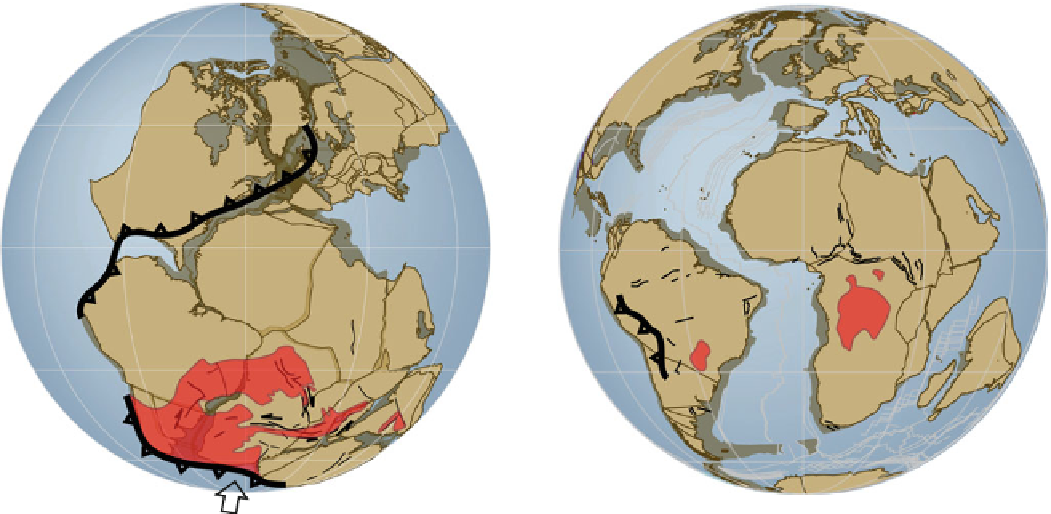Geology Reference
In-Depth Information
EPISODE A
EPISODE B
Plate reconstruction at 260 Ma
Plate reconstruction at 83 Ma
30˚N
3 0 ˚ N
Equator
Equator
3 0 ˚ S
30˚S
na
Fig. 11.8
Gondwana and Pangea plate-reconstructions (http://www.gplates.org), illustrating the two different geodynamic contexts during the
two main episodes of subsidence of the CB (
A
and
B
in Fig.
11.5
)
are largely attenuated or absent in all the four borehole-
sections (Fig.
11.3
). This suggests a long episode, up to
150 million years, of non-deposition and/or erosion in the
center of the CB during the early Paleozoic (Fig.
11.7a
).
During and following the main Dwyka glaciation
(Fig.
11.7b
), and the amalgamation of Gondwana into
Pangea (ca. 300 Ma; Domeier et al.
2012
; Kroner and
Romer
2013
), the Carboniferous to Triassic Lukuga and
Haute Lueki Groups were deposited during the first and
longest (~150 million years) Episode A of accelerated sub-
sidence of the CB (Figs.
11.5
and
11.8
). The lowermost
glacial and deglaciation sequences (the Lukuga Group) are
best preserved in the Mbandaka (1,400 m thick), Gilson
(1,300 m thick) and Dekese (900 m thick) sections of the
western and southern parts of the basin (Fig.
11.3
). These
sequences are interlayered with relatively thick, dark
(organic-rich) siltstones and black shales that herald the
initial phase of basin deepening (i.e. transgression). This
transgression in the CB is largely equivalent to that of the
Dwyka and Lower Ecca Groups in the Karoo Basins of
southern Africa, and most probably links to the final rapid
deglaciation of Gondwana and sea level rise followed by
isostatic rebound during the Early Permian (e.g. Visser
1995
; Scheffler et al.
2003
; Frank et al.
2008
; Monta˜ez
and Poulsen
2013
). The overlying fluvial (and aeolian?)
sequences of the Triassic Haute Lueki Group of the CB are
remarkably thick in the Mbandaka (1,750 m), Samba
(900 m) and Gilson (550 m) sections (Fig.
11.3
), and repre-
sent a more rapid phase of basin infilling (i.e. regression).
Although the ages of these units are relatively poorly
constrained (Linol
2013
; see Chap.
7
, this Topic), these are
here considered to be equivalent to the Beaufort Group of the
Karoo of southern Africa, ca. 180-260 Ma (Catuneanu et al.
2005
; Johnson et al.
2006
). This marked Permian-Triassic
regression of the CB is therefore roughly contemporaneous
across central and southern Africa and overlaps in time with
the Cape-de la Ventana orogen (ca. 250 Ma) flanking the
southern margin of Gondwana (e.g. the Gondwanides; du
Toit
1937
; Daly et al.
1992
; Trouw and de Wit
1999
; Newton
et al.
2006
;P´ngaro and Ramos
2012
; see also Chap.
13
, this
Topic).
The upper, most pronounced and laterally extensive
unconformity across the Carboniferous to Triassic sequences
in the CB coincides with the onset of break-up between East
and West Gondwana and the resulting opening of the Indian
Ocean (ca. 160-180 Ma; Reeves
1999
; Jokat et al.
2003
;
Moulin et al.
2010
; Torsvik et al.
2012
; Heine et al.
2013
).
Thereafter, the Stanleyville, Loia, Bokungu and Kwango









Search WWH ::

Custom Search